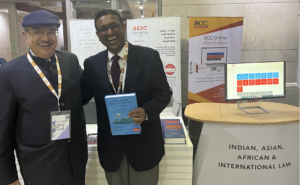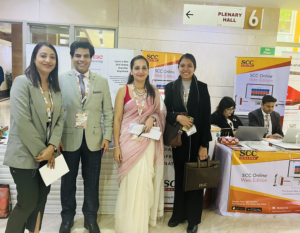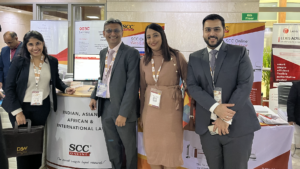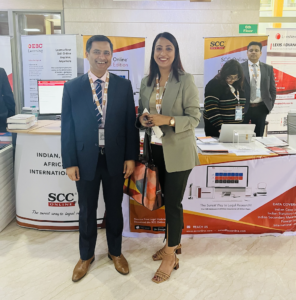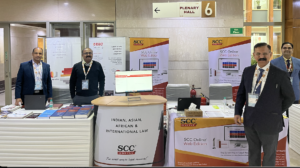Delhi Arbitration Weekend, 2023: The Delhi International Arbitration Centre (‘DIAC’) brings together the global arbitration community, by hosting its first ever edition of Delhi Arbitration Weekend, 2023 (‘DAW’). The event aims at building a network of experts, practitioners and academia, by engaging them in dialogues and panel discussions, led by renowned legal luminaries, judges and experts in the field of arbitration, from across the globe.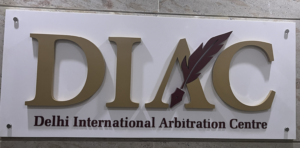
DAW has invited various International Arbitration Institutions and key representatives/partners of the top International and Indian law firms specialising in dispute resolution to contribute towards the resolution of challenges confronting the arbitration community. DAW has received over 1380 applications for 350 seats.
The event focuses on recent trends and developments in both Domestic and International Arbitration and aspires to identify and evaluate the best practices in arbitration that can be integrated into the mainstream.
Spread over multiple sessions, starting from 16-02-2023 to 19-02-2023, and powered by distinguished experts and speakers from over 14 countries.; DAW would be the centre stage for envisaged upon the contemporary issues and challenges in the arbitration space.
FEBRUARY 16, 2023 (5:00 P.M. – 6:30 P.M.)
INAUGURAL
Chief Guest: Hon’ble Dr. Justice D.Y. Chandrachud, Chief Justice of India
Guest of Honour: Lord (Peter) Goldsmith KC, PC (Chair of European and Asian Litigation, Debevoise & Plimpton; Former Attorney General of England and Wales and Northern Ireland)
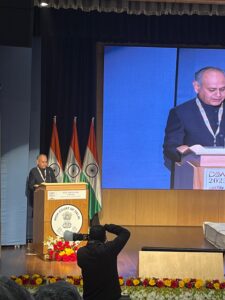
The welcome address was given by Justice Vibhu Bakhru, Chairperson, DIAC. He said, the DIAC has framed new set of rules that will come into effect from 01-04-2023, the new rules provide for scrutiny of draft awards, the arbitral tribunal is required to submit the draft award to the coordinator, for scrutiny by a committee before delivering the same, the draft award will be reviewed for typographical errors, better formatting and other issues. The Comments of the committee will be forwarded to the Arbitral Tribunal for its consideration. We believe this will improve the quality of awards, as it is necessary to build an environment of accountability and transparency. The new rules also provide for publication of awards on the Centre’s website, however, the parties can keep the awards confidential, prior to publication.
He said that DAW is yet another initiative to act as a catalyst and bringing together professionals in the field of arbitration in a single platform for a dialogue on various aspects on arbitration law. We have 69 delegates participating from 14 countries.
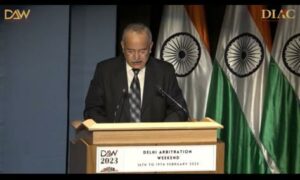
Justice Satish Chandra Sharma, Chief Justice, Delhi High Court said, DAW a brain child of DIAC ,this three days conference is going to be a confluence of some of the best legal minds from across the world. The entire effort has been put in recognition of the fact that the arbitration has acquire the centre stage in the global dispute resolution process. We live in a world in which the reality of globalisation often finds itself in a confrontation with municipal laws and systems, wherein different legal regimes control the fate of commercial transactions having a multinational bearing. In such a scenario the true impact of a global partnership could not be realised unless we adopt a uniform system for dispute resolution. Such a system will differ in its shape and form from one jurisdiction to another, however it must be based on a common jurisprudential ground.
Further, he said that International arbitration has been emerged as a great unifying force which has invariably infused the element of trust building in commercial transaction.
Justice Sharma also said that, today we stand in cognition of a unifying effect of arbitration as a model of dispute resolution. The dispute resolution in India is not a discovery of the present century, we had in this country an ancient system of dispute resolution. Since time immemorial, village counsels have been first formed and first forum of dispute resolution for a significant ruler for the population of this country.
He also said that the underlying element that formed the basis of this ancient system , was the ‘element of trust’. Even today, the efficacy of arbitral proceedings is based on trust. The trust that parties impose on the arbitrators and institutions.
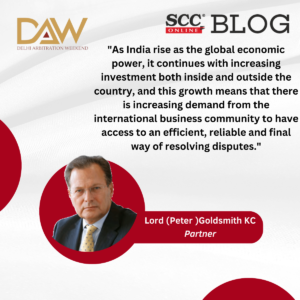
The Special Address was given by Guest of Honour Lord (Peter) Goldsmith KC, PC, he said that the Indian domestic courts are occupied with heavy case load. For any country to become a leading hub for international arbitration requires a strong foundation. In his view, India’s foundation has been strengthened over the years, as India has an exceptional Advocates and Solicitors doing strong dispute resolution and commercial arbitration practices. He said that the strength of the Indian legal profession is well known , increasingly attracting international attraction of global law firms.
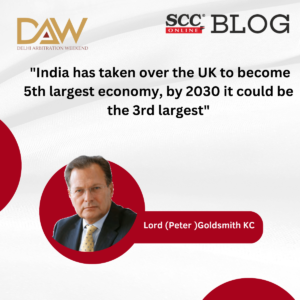
Further, he said that he had the privilege of working with, sometimes against Indian lawyers, and they make outstanding team mates and formidable opponents. Also, Indian Judicial decisions today are pro arbitration , compared to the past and Indian Judiciary is continuing to play an active role and providing critical support for the arbitral process.
The Keynote address was given by Dr. Justice D.Y. Chandrachud, Chief Justice of India. He said that India has a checkered history with arbitration. Legislative and judicial amends to move towards being a pro-arbitration jurisdiction. This doesn’t mean that there was no judicial intervention in arbitration.
 He said that with a vision to do away with the issues of the earlier regime and transform India into arbitration friendly country, the 1996 Act was largely based on UNCITRAL model law which reflected the prevailing consensus on the best practices in arbitration across the globe. Unfortunately, the progress of advances through the spirit of 1996 legislation were overshadowed by some of the judgments in judicial side.
He said that with a vision to do away with the issues of the earlier regime and transform India into arbitration friendly country, the 1996 Act was largely based on UNCITRAL model law which reflected the prevailing consensus on the best practices in arbitration across the globe. Unfortunately, the progress of advances through the spirit of 1996 legislation were overshadowed by some of the judgments in judicial side.
Further, he added that the 2015 amendment through insertion of explanation of Section 34 narrowed down the scope of court’s interference with arbitral award and grounds of being against public policy.
He believed that all stakeholders must work together to ensure that arbitration does not remain the choice of dispute resolution only for parties with large commercial ventures. Smaller businesses as well as individuals must be encouraged to include arbitration clause in contracts. This will also require arbitrations to be more 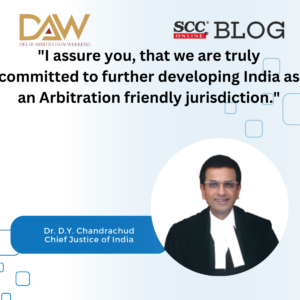 affordable.
affordable.
He said that we need training for lawyers as well , because lawyers as much as judges need to be part of the process of the whole mission/ movement.
In his view, the Delhi Arbitration Weekend is a perfect opportunity to put heads together & discuss some of the challenges and upcoming issues in the arbitration arena.
DAY 1: FEBRUARY 17
The first session(1A) chaired by Mr. Justice Uday Umesh Lalit on Day 1 relates to the discussion on Challenges and Issues in Arbitration Ecosystem: Is Institutional Arbitration ‘the’ Solution?

The Speakers of the event are Ms. Zarina Chinoy (General Counsel, EPC Division, Shapoorji Pallonji Group), Mr. Vijayendra, Pratap Singh (Partner and Head Litigation, AZB & Partners) and Mr. Tejus Chauhan (Director, South Asia, ICC International Court of Arbitration).
As we progress towards the first day in the Delhi Arbitration Weekend, the event featured various experts from across the globe.
The day started with the address of Uday Umesh Lalit J., as the moderator and various eminent speakers.
Zarina Chinoy gave a very chiseled approach to arbitration and stated that she prefers to minimize the exposure of her group to ligation, reason being that Indian Courts are over whelmed and overburdened. Most of the ‘construction documents’ are voluminous; the projects take anywhere between 3-10 years to complete and witness evidence and documentation is inconsistent. If the same is taken to Court, the amount of time that it may take is incomprehensible and may result into gigantic expense for the parties.
She further said that majority of the construction contracts with the government or the private institutions contains arbitration clauses, which are carefully word specifically stating the seat and venue of arbitration, the law that will prevail, jurisdiction, and the number of arbitrators to be appointed depending upon the claims according to the contract. The pre-requisite to appointing of an arbitrator is that they should be quick, impartial, fundamental knowledge of the procedure, time to dedicate to the process and the required skill sets. It is also expected that the award will be stated quickly and cannot wait indefinitely.
Whereas Vijayendra Pratap Singh stated that the arbitration clause was like a ‘tadka’ or a ‘seasoning’, as it’s the last thing in a contract and the first thing one will taste when a dispute takes place unlike the rest of the contract. He stated that the Arbitration clause was the only ‘divorce clause’ in the agreement so one has to provide for risk at the heightened sense since people may or may not cooperate. Therefore it has to fulfill 3 Es:
- Efficiency
- Economy
- Effectiveness
If one is able to fulfil a contractual promise by making sure its enforceable, one bring about the ease of doing business and bring down the cost of doing business . He was of the view that the Arbitration was like a supplement to the process of dispute resolution available in Courts which allow access to justice while reducing the pipelines that go to Court.
“Institutional arbitration effectively vaccinates the process against dilatory tactics and is effectively an answer to gorilla noncooperation that takes place regularly.”
Further, on the question of ad-hoc arbitration or Institutional Arbitration, he quoted that “there is flexibility, and flexibility brings accountability, but be careful what accounts you want.”
Tejas Chauhan pointed out that ICC over the last 10 years have seen that there is growing preference for Institutional Arbitration. At the beginning of the year 2000, ICC had over 300-400 cases which went upto about 900 till the year 2020.
He stated that it was not only the commercial sector but economic sector also ventured in ICC which come from life sciences , pharmaceuticals, insurance , trade and alike. While emphasizing on the fact that institutional arbitration was not expensive.
He further stated that it’s a general belief that the amounts in dispute in institutional arbitration and international arbitration are only at the higher side but in the year 2021, ICC handled disputes from amounts ranging from 9000 dollars to 27 billion dollars. The case load in ICC also handled domestic cases in which there were two Indian parties resultantly the arbitration seat being in India.
The first session (1B) chaired by Mr. Justice Arjan K. Sikri on Day 1 relates to the discussion on Limits to Party Autonomy in Arbitration and Emergence of Commercial Courts.
The Speakers of the event are Mr. Stephen Moriarty KC (Barrister, Fountain Court Chambers), Mr. Gaurav Pachnanda (Senior Advocate, Supreme Court of India) and Ms. Renu Gupta (Partner, Olive law).
Justice AK Sikri said that when parties go to arbitration , they don’t want Court system , they want that the dispute should be decided in a private forum chosen by them. This is the principle behind mediation as well. This freedom should be given to them.
He said that , the law recognises, the society recognises and the system recognises that it is not necessary for the parties to approach the Court only, if they want their disputes to be resolved in a particular manner, outside the Court system then they are free to do so. Here, the question of party autonomy comes. This is the jurisprudential basis of party autonomy.
As per Justice Sikri, Arbitration and Conciliation Act also recognises this and contains provisions that what kind of freedom needs to be given to the parties.
Gaurav Pachnanda said that over the last few years there were two competing trends emerging, both from the manner in which legislative intervention has taken place in arbitration law and also in the manner in which Courts have interpreted and applied arbitration law in India.
As per him , in the last few years there was an attempt , by the Courts to stretch the envelope and make our conventional notions of how law should be defer to party autonomy in matters relating to arbitration law.
Renu Gupta has thrown some light on the limitations to party autonomy in arbitration, and said that even though arbitration and Courts are looked as separate forums , but they are not.
The party autonomy and the limitations to party autonomy need to be seen from a different lens , not as a restriction but as something that helps in dispensation of justice.
Explaining the emergence of Commercial Courts Stephen Moriarty KC said that their is no link between party autonomy and emergence of commercial Courts.
He also said that there are number of respects in which the international commercial Courts can fill the gaps that is provided by limitation on party autonomy, like it can allow joinder of parties.
The second session (2A) chaired by Mr. Justice Hemant Gupta (Former Judge, Supreme Court of India) on Day 1 relates to the discussion on Should Patent Illegality as a Ground Continue in Domestic Arbitration?
The Speakers of the event are Ms. Sherina Petit (Partner, Norton Rose Fulbright LLP), Ms. Payal Chawla (Founder, Jus Contractus) and Mr. Anirudh Krishnan (Founding Partner, AK Law Chambers)
The question of “Should Patent Illegality as a Ground Continue in Domestic Arbitration?” was addressed by Justice Hemant Gupta.
Talking about the initial days of Arbitration and Conciliation Act, 1996 coming into force, Justice Hemant Gupta shared his thoughts that “a plain reading of Section 34 regarding conflict with the public policy of India hinted of being a debatable issue which would sooner than later come up before the Court. After 26 years, we are still debating on what is the public policy of India which gives rise to setting aside of an award under the Act.”
As opined by Justice Hemant Gupta, the exclusion of International Arbitration from the grounds of patent illegality in Section 34 (2-A) begets confusion. The provision probably grants the domestic parties with an incentive to opt for international arbitration and get away from the domestic one. It is an indirect way of getting away from domestic award which is going to be challenged in Court. According to Justice Gupta, this gives parties with an option to go for foreign seats of arbitration and be governed by the laws accordingly. By this, we are indirectly persuading parties/ giving incentive to parties to choose foreign arbitration, which is not a good idea. We should do away with Clause 2(a) and provide an equal playing field in respect of national and international arbitration.
The second session (2B) chaired by Ms. Justice Indu Malhotra (Former Judge, Supreme Court of India)on Day 1 relates to the discussion on Increasing Diversity and Access in Arbitration: Role of the Stakeholders.
The Speakers of the event are Mr. Rajesh Pillai KC (Barrister, Three Verulam Buildings), Ms. Pallavi Shroff (Managing Partner, Shardul Amarchand Mangaldas & Co) and Mr. Vyapak Desai (Senior Attorney, Nishith Desai Associates)
Justice Indu Malhotra began with discussion over diversity issues in the arbitral panel for disputes in various kinds of international commercial arbitrations. According to her, investment treaty arbitrations have come under a serious apprehension and there is a legitimacy deficit, as also expressed by people on ground in the developing countries that arbitration panels are constituted by Westerners who are not familiar with the peculiar situations prevailing in the developing countries.
Regional diversity is equally important according to Justice Indu Malhotra, because people from certain parts of the globe may not be familiar with the problems faced by developing countries, because they have their own peculiar problems.
Advocating for diversity amongst the decision makers, Justice Indu Malhotra suggested that improving gender diversity will also introduce fresh plans for arbitral tribunals which are necessary to maintain a sustainable pool of arbitrators.
She added that “In fact, the number of women arbitrators is abysmally low, and I think that positive effort must be made to increase a pool with a large number of women who have taken to arbitration as an avocation and are available in various parts of the world.”
The third session (3A) chaired by Mr. Justice L. Nageswara Rao (Former Judge, Supreme Court of India) on Day 1 relates to the discussion on Corruption in Arbitration: Knowing the Unknown
The Speakers of the event are Ms. Sapna Jhangiani KC (Attorney-General’s Chambers, Singapore), Mr. Francis Xavier SC (Regional Head, Dispute Resolution Group, Rajah & Tann Singapore LLP) and Mr. Nusrat Hassan (Co-Managing Partner, Link Legal)
Addressing the topic ,Justice L. Nageswara Rao began with discussing the initial days of arbitration law in India, when cases of fraud and corruption were alien to arbitrable matters triable by a civil court for want of evidence and the need for judge to look at the complaints in a different way in the court of law. After few rounds of Supreme Court judgment followed by Law Commission report examining the change in provisions, the Supreme Court regarded the judgment delivered earlier for non-arbitrability of corruption and bribery bad law and went on to deal with allegations of corruption by saying that these can be subject matters of arbitration.
Connecting the dots between arbitration and fraud, Justice Nageswara said that “When it comes to arbitrators themselves indulging in corruption, it can be active or passive corruption. There can be corruption for monetary rewards. A quintessential example of corruption would be both actual and future payments made to the arbitrator for delivering an award. There might be non-monetary awards as well, which include any form of other compensation including the prospect of future arbitral appointments.”
Now, putting forward the question of “How do you find out fraud and prove these methods of corruption amongst arbitrators?”, Justice Nageswara discussed at length the dilemma of non-applicability of condonation of delay under Limitation Act due to Section 34 of Arbitration and Conciliation Act, 1996 which provides for limitation for entertaining an application under Section 34 as 30 days.
The third session (3B) chaired by Mr. Justice Badar Durrez Ahmed (Former Chief Justice, High Court of Jammu and Kashmir) on Day 1 relates to the discussion on Reimagining Arbitration in a Post-Covid World: Right to Physical Hearing
The Speakers of the event are Mr. Constantine Partasides KC (Partner, Three Crowns), Ms. Pinky Anand (Senior Advocate) and Ms. Neeti Sachdeva (Secretary General and Registrar at Mumbai Centre for International Arbitration)
Justice Badar Durrez Ahmed began by stating that we have to examine the situation prior to Covid, during Covid and after Covid, that is how arbitration hearing evolved. As per his experience as an arbitrator, every hearing was physical hearing, and during Covid physical hearing came to a complete halt.
He remarked that, now everyone is comfortable with remote hearing.
Further, he said that the advantages and disadvantages of physical hearing and remote hearing needs to be examined.
Neeti Sachdeva expressed that India needs to be a leading light in institutional arbitration, and for institutions to be joining hands and promoting it will go a long way in making India do what we all dreamt of.
Pinky Anand said that the efficacy of remote hearing is principally built on connectivity and the technology being available. There needs to be inter se communications.
Constantine Partasides KC said that the advent of remote hearing was an absolute Godsent, as we continued to work during Covid as well.
In his opinion, we are undoubtedly going to retain the remote hearing as one of the choices open to us for the resolution of any case. It is a part now of arbitration menu and it is not going anywhere. But, whether it is a correct choice for a particular case, is really the question.
The fourth session (4A) chaired by Mr. Justice Deepak Gupta (Former Judge, Supreme Court of India) on Day 1 relates to the discussion on Adjudicating Construction Arbitration Claims: The Asian Perspective
The Speakers of the event are Mr. Julian Bailey (Partner, Jones Day, London), Mr. Ratan K. Singh (Senior Advocate; Founder and Chairman, Society of Construction Law) and Mr. David Thomas KC (Keating Chambers)
Discussing the topic, Justice Deepak Gupta commented that the bread & butter for arbitration in India is ‘Construction Arbitration’ since almost 2/3rds of arbitration matters arise from construction arbitration.
Justice Gupta is of the opinion that we need to develop our own construction jurisprudence with an Indian perspective.
Talking about Indian arbitration following the formulae laid by the Western world, Justice Gupta said that “While handling some construction arbitrations as an arbitrator, I have found that we normally blindly follow the Hudson Formula derived from Hudson Building and Engineering Contracts without even seeing what the evidence is. The basis must be the evidence and not the formulae since formulae only follow based on evidence. These formulae have evolved in the Western world having a completely different environment of construction as well as finance. There, the labour rates are much higher. In India, construction process is very much labour intensive, our inflation rates are also different as compared to the Western world.”
The fourth session (4B) chaired by Justice Shiavax Jal Vazifdar (Former Chief Justice, High Court of Punjab and Haryana) on Day 1 relates to the discussion on International Commercial Arbitration: Lessons from West and East
The Speakers of the event are Prof. Dr. Jacomijn van Haersolte-van Hof (Director General, London Court of International Arbitration), Mr. Manish Aggarwal (Co-Chair, Young International Arbitration Group, London Court of International Arbitration; Partner, Three Crowns) and Mr. J William Rowley KC (Barrister, Twenty Essex)
Justice Shiavax Jal Vazifdar quoted CJI’s yesterday address at the inaugural function that sums up the value of this event , wherein he said that “this event sums up India’s arbitration ecosystem.”
He emphasised that there are two issues , first category is reciprocity , uniformity, comity, certainty and the second category is with respect to the finality of the reference.
On the first category, he said that the question is as to whether an annulled award at the Courts where there is the seat can be enforced in another jurisdiction.
Pressing on the practice to revisit the law and legislation from time to time, Prof. Dr. Jacomijn van Haersolte-van Hof commented that “In order to stay best in class, you need to keep an eye on things, you need to make sure that your legislation is best in class, and that includes looking at other jurisdictions as well.”
DAY 2: FEBRUARY 18
The Day 2 commenced with discussion on the topic Appointment of Arbitrators : Discussing the Role of Judiciary, Institutions and Parties chaired by Mr. Justice Sanjiv Khanna (Judge, Supreme Court of India).
The Speakers of Session 1A were Mr. Justice K.R. Shriram (Judge, High Court of Bombay), Ms. Leigh-Ann Mulcahy KC (Advocate & International Arbitrator, Fountain Court Chambers) and Ms. Chiann Bao (Independent Arbitrator and Mediator) and the session was moderated by Ms. Radhika Dubey (Independent Counsel & Arbitrator).
Talking about his long association with DIAC, Justice Sanjiv Khanna said that he has seen DIAC growing in terms of number of cases.
Examining the figures regarding total number of matters referred to arbitration, Justice Khanna said that more than 1 lakh civil suits were instituted in subordinate courts, and 3964 suits were instituted in Delhi High Court, but barely 489 matters were referred to DIAC. Referring to the reasons why arbitration is not accepted as an alternative adjudication process, he mentioned Vidya Drolia v. Durga Trading Corpn., (2019) 20 SCC 406, listing out some of the apprehensions of litigants for arbitration:
- The fact-finding process in arbitration is not equivalent to Judicial fact finding, which is far more comprehensive.
- There is limited lack of reasoning in awards.
- Arbitrators enjoy extensive powers and are prone to making arbitrary and despotic decisions.
- Arbitration proceedings are private and confidential.
- Arbitration expensive
- Arbitrators are unfit to address issues arising from economic power and concerns etc.
Justice Khanna added that “Arbitration and Conciliation Act, 1996 brought about a big change and there are judgments of Supreme Court, holding that the process of appointment of an arbitrator is a purely administrative act and not a judicial act.”
The issue of party affiliation is also a matter of concern according to Justice Khanna, since there is affiliation bias in arbitrator towards the party who nominates him/ her, tending to support that party, and this fact is seldom realized by the arbitrator.
Leigh-Ann Mulcahy KC addressed the role of parties in making appointments, she said that the ability of parties to appoint their arbitral tribunal is probably the most widely accepted norm of arbitration, it is the central characteristic of party autonomy, it is reflected in the institutional rules and also in the Arbitration Act. She further talked about the issue of unequal appointment rights.
Session 1B commenced with the address of Justice Hrishikesh Roy (Judge, Supreme Court of India) on the topic ‘The Great Debate: Confidentiality vs. Transparency in Arbitration’. Dr. Justice Anita Sumanth (Judge, High Court of Madras),Dr. Birendra Saraf (Advocate General, State of Maharashtra) and Mr. Kevin Nash (Registrar, Singapore International Arbitration Centre) were the speakers for this session.
Connecting the dots of confidentiality in various professions, Justice Roy expressed that “Historically and traditionally, arbitrations are considered to be private in nature, so that parties may resolve their disputes through a trusted mechanism without public exposure. Many consider confidentiality to be a key advantage of arbitration as a dispute resolution mechanism.”
Comparing the concept of confidentiality in arbitration with various countries, Justice Roy raised the question of “Should we in India try to balance by opting for publication of redacted words to meet confidentiality expectations?”
Discussing the transparency in the context of arbitration, Justice Roy raised the key questions pointed out below:
- Should all submissions in an arbitration be made publicly available, or is it only limited information which should be made available publicly?
- Should 3rd parties be entitled to file written statements with the arbitral tribunal regarding matters within the scope of dispute?
- If so, who are those 3rd parties, who should be allowed to?
- Should arbitration hearings be public or private?
- In balancing the needs of parties, how to protect confidential information if no part of the proceedings is kept confidential?
Speaking of confidentiality in arbitration, Mr. Kevin Nash (Registrar, SIAC) found the need to be provocative with the following propositions:
- How much different would we treat confidentiality if instead of calling it confidential, we call it secret?
- What is the mandate of an institution? What is an institution supposed to develop jurisprudence?
According to him, there is a recipe for developing a destination for arbitration; you need the requisite hardware and software. And he also praised for the number of cases are being administered by the DIAC in such a short amount of time, for which he believes that the Arbitration and Conciliation (Amendment) Acts of 2015 and 2019 have really moved things forward.
Session 2A was chaired by Mr. Justice S. Ravindra Bhat (Judge, Supreme Court of India) for discussing the topic of ‘Taming the Unruly Horse: Public Policy in International Arbitration: India/UK/Singapore’. The Speakers of the session are Dr. Justice S. Muralidhar (Chief Justice, High Court of Orissa), Mr. Darius J. Khambata (Senior Advocate) and Mr. Vernon Flynn KC (Barrister, International Advocate & Arbitrator at Brick Court Chambers)
Justice Bhat started by quoting Burrough J’s famous words “Public policy is a very unruly horse, and when you get astride, you never know where it will carry you” said in 1824. He explained that “We are still grappling with that unruly horse almost 200 years later. Whether you call ‘Taming it’ or ‘Saddling it’, we have not yet been able to reach a consensus and I suspect, we can never do that. The intent of the provision as regards the necessary interpretation points to a national public policy of the country of the enforcing Court.”
Going forward with the context, he further explained that the public policy would not exactly be the same as another. And that existence of different standards in countries highlights their national public policy and this can result in quite different interpretations of that term.
Session 2B commenced with the address of Justice B.R. Gavai (Judge, Supreme Court of India) on the topic of ‘Conflict of Interest’: Do’s and Don’ts for Arbitrators ‘. Justice Moushumi Bhattacharya (Judge, High Court of Calcutta), Shyam Divan (Senior Advocate) and David Brynmor Thomas KC (39 Essex Chambers) were the speakers for this session.
While addressing the session, Justice Gavai stated that the topic for the present session strikes at the very core of the efficacy of the Alternative Dispute Redressal Mechanism. He was of the view that the principal against ‘bias’ emerges from the Latin maxim that ‘no man should be a judge at his own cause’. He opined that for those in the judicial system, impartiality is ensured by the exclusion from the judge’s life coupled with power to recuse from hearing matters where conflict of interest may arise.
Justice Gavai emphasised that freedom from bias is a crucial component of principal of natural justice which permeates the legal system in most common law nations be it UK or India. This principle serves to fortify the trust that the citizens of this nation having such a judicial system will help to fulfil the quest of fair decision-making process.
Justice Bhattacharya spoke about the guidelines on conflicts of interest on international arbitration and stated a few pointers:
1. Non-waivable red list– which primarily meant that no person could be his own judge and even acceptance by the parties could not cure the conflict.
2. Waivable red list– even though serious in nature but not as severe as the non-waivable red list. Such were the issues that were waivable by agreement between the parties.
3. Orange list– stated such situations that would give rise to justifiable doubts, and it was the arbitrators duty to disclose such issues.
4. Green list– states no actual conflict of interest resultantly no duty to disclose arise in such situations.
The topic of ‘Emergency Arbitration and its Developing Contours in India’ was discussed in Session 3A chaired by Ms. Justice Hima Kohli (Judge, Supreme Court of India). Mr.Justice A.K. Jayasankaran Nambiar (Judge, High Court of Kerala), Mr.K.V. Vishwanathan (Senior Advocate) and Mr. V.K. Rajah SC (International Arbitrator, Duxton Hill Chambers) were the Speakers for this session.
Justice Hima Kohli started with demonstrating Emergency Arbitration (‘EA’), also known as Expedited Arbitration, which has emerged as a critical mechanism for resolving a part of the dispute that may require an urgent resolution prior to the proceedings commencing before the arbitral tribunal or during the course of such proceedings. EA is an ideal solution for disputes requiring solutions on an urgent basis, as suggested by Justice Kohli.
She expounded that the use of EA in India is growing, particularly due to the increasing awareness of the benefits of ADR methods to avoid the long and cumbersome process of civil litigation. She added that “Despite its growing popularity, there are several challenges to be overcome by the initiative of EA, mainly the opacity in the rules and procedures and the lack of awareness among the stakeholders about the availability of mechanism of EA and its benefits.”
Mr. V.K. Rajah acquainted everyone with the idea of having Emergency Arbitrator, which first started taking shape in the 1990s and was opted procedure for some arbitral tribunals, including WIPO. He added that “The ICDR-AAA made the appointment of an emergency arbitrator as default mechanism for the first time in 2006, and that became viable very quickly. At that time, many in the arbitral community realized that there would be a problem with enforcement because when the New York Convention was first drafted, no such feature existed. There was a strong pre-disposition as well to read the Convention to only applying to final awards rather than orders.”
Mr. K.V. Vishwanathan expressed that Emergency Arbitration is needed, but there are some basic problems that may arise in enforcing the EA awards in a foreign seated arbitration.
Session 3B involved discussion over ‘Modern Boundaries of Investment Treaty Arbitration’. The session was chaired by Mr. Justice P.S. Narasimha (Judge, Supreme Court of India), and the speakers for the session were Mr. Justice Devan Ramachandran (Judge, High Court of Kerala), Mr. Gourab Banerji (Senior Advocate) and Prof. Doug Jones AO (International Arbitrator)
Justice Narasimha introduced the context as “The law governing treaties is basically in the realm of public international law, and Investor-State Dispute Settlement (‘ISDS’) Mechanism was an innovation designed to depoliticize and streamline investment isputes by allowing investors to directly make claims against the state under bilateral and multi-lateral treaties only to protect the wealth and property of foreign investors.”
He suggested that the failure of States in anticipating the varied problems that would manifest from ISDS mechanism needs to be seen. States had no role with respect to ISDS.
Justice Ramachandran, speaking about the changed position of a private individual in public international law stated that “Historically, the public international laws would never treat an individual as a subject and were deprived of a legal personality except in cases of war or revolutions. But that has undergone a complete change when in commercial transactions, States began to underwrite the investor’s concerns.”
As illustrated by him, originally, a private individual would have to tap on the diplomatic channels of his State, reach out to the investing State and get his grievances redressed, or at the best, he would have been treated as an alien under the customary public international law under the minimum standard protection concepts. However, over the years, if one looks at the bi-lateral treaty or multilateral investment treaties these days, it encompasses future disputes relating to indeterminate prospective investors to cover a wide gamut of governmental regulatory regimes.
Session 4A corresponds to discussion over ‘Supervisory Powers of Courts at the Seat: Lex loci’. The Mr. Justice Surya Kant (Judge, Supreme Court of India) chaired the session, Dr. Chintan Chandrachud (Barrister, Brick Court Chambers) moderated the same, and speakers for the session are Mr. Justice M. Sundar (Judge, High Court of Madras), Mr. Parag P. Tripathi (Senior Advocate).
Dr. Chintan Chandrachud initiated with the realization of the situation that “It’s fair to say that the supervisory powers of Courts are amongst the most controversial subjects in Indian arbitration jurisprudence over the last 2 decades. And the difficulty is where do you draw the line between supervision and control?
He threw some important questions in this context that “Is supervision in itself the correct characterization?” and “Should we be using support instead of supervision, as the English Courts frequently do?”
He then came up with the question of “What is the role of Courts when it comes to referring parties to arbitration where there is an arbitration clause or an arbitration agreement in place?” for Justice Surya Kant who referred to the legislative mandate in Section 8 of Arbitration and Conciliation Act, 1996 using negative terminology. Expressing his thoughts, Justice Surya Kant said that the Court will ordinarily presume that there exists a valid arbitration agreement between the parties and the matter needs to be referred for arbitration adjudication. The Court will have to satisfy that there is no valid arbitration agreement and thereby refer the dispute to arbitration. Hence, the Court’s approach would be not to go deep into the questions/issues falling upon the arbitral tribunal.
Dr. Chintan Chandrachud invited Mr. Parag P. Tripathi to address the question of “What is the interaction/ interplay between Section 8 and Section 11 of Arbitration and Conciliation Act, 1996?” to consider the Court’s power to refer and power to appoint.
Mr. Parag Tripathi commented that Arbitration and the Court System have a delightful tension, which is now being constructively used. Referring to Section 5 of the Act, which restricts Court’s interference in arbitration except as expressly provided, which has been rightly referred to as the declaration of independence of the Arbitral Tribunal, as pointed out by Mr. Tripathi.
Session 4B commenced with the address of Justice A.S. Oka (Judge, Supreme Court) on the topic ‘Taking of evidence in Arbitration: Are there any rules of the game?’. Justice R.D. Dhanuka (Judge, Bombay High Court), Kelvin Poon SC (Deputy Manager Partner, Rajah & Tann) and Meenakshi Arora (Senior Advocate) were the speakers.
Justice Oka introduced the subject and flagged few concerns in the Indian context. He referred to the 1996 Arbitration Act and stated that parties by agreement can decide the procedure to follow in the arbitral proceedings. He stated that the ultimate object was to give a lot of freedom to the arbitral tribunal and avoid all technicalities which are there in our traditional civil courts so that the time spans in such proceedings are reduced.
He went on to state that we have to consider Section 19 in the context of the procedure followed by the traditional courts, which are bound by the Civil Procedure and strict rules of the Evidence Act.
Justice Oka explained that the object of ensuring that there is expeditious disposal of arbitration proceedings, we have special rules under the Arbitration Act where a lot of freedom is given to the Arbitral Tribunal. He was of the view that in the Indian context we have to see whether we have really succeeded in the object for which these provisions were enacted.
Stating his own experience, he mentioned that “the evidence recorded in Arbitral proceedings is very bulky and lengthy and the same evidence could be recorded by our traditional Courts in a much concise form. Absence of procedure laid down in the Statute and Rules create such a difficulty. Such documents are placed on record which normal Courts will not permit and the aim is to change such practices.”
VALEDICTORY: FEBRUARY 19
The Chief Guest for the occasion is Sh Kiren Rijiju, Hon’ble Union Minister of Law and Justice, and the Guest of Honour is Hon’ble Mr Justice Sanjay Kishan Kaul, Judge, Supreme Court of India.
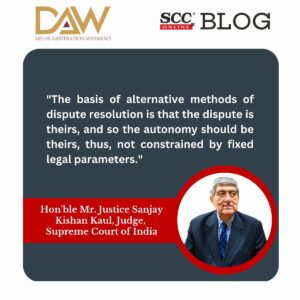 The Topic for the concluding session is – Arbitration Vision 2030: What the Future Beholds?
The Topic for the concluding session is – Arbitration Vision 2030: What the Future Beholds?
Justice Sanjay Kishan Kaul delivers his special address on the occasion by talking about Arbitration vision. He says Arbitration evolves with time and constantly reflects the need of the parties in dispute. He also talked about the Mediation Bill which might come into force this year is also geared toward this institution and another forum to alternate dispute resolution. A campaign for greener arbitration has encouraged more sustainable development and less carbon.
Justice Kaul also focused on the importance of virtual hearings and how virtual system actually increased the efficiency of court system. He personally prefer hybrid system.
We have to ensure that we learn from each other without any conflict of interest. Especially for institutional arbitration, It is essential new centers are established across the nation.
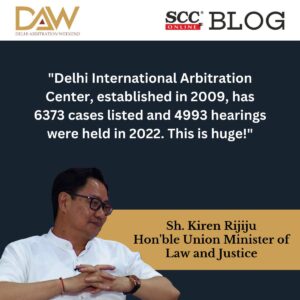
Mr. Kiren Rijiju on making India as a International Hub for Arbitration, said that the Delhi International Arbitration Center established in 2009, has 6373 cases listed and 4993 hearings held in 2022. This is huge.
Mr Kiren Rijiju suggested consequential change in legal studies curriculum, promoting specialised study of ADR mechanism. Also, he focussed on Indian courts going paperless.
Ms. Justice Rekha Palli, Member, Delhi International Arbitration Centre gave her Vote of Thanks by saying the last 3 days has been so special and eventful. The huge participation from 14 nationalities for this event is unprecedented. She also mentioned 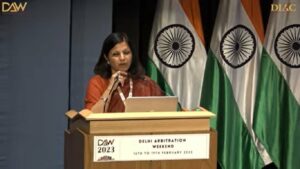 that DAW has culminated today with reflections on what lies for the future of arbitration.
that DAW has culminated today with reflections on what lies for the future of arbitration.
EBC/SCC ONLINE KIOSK
